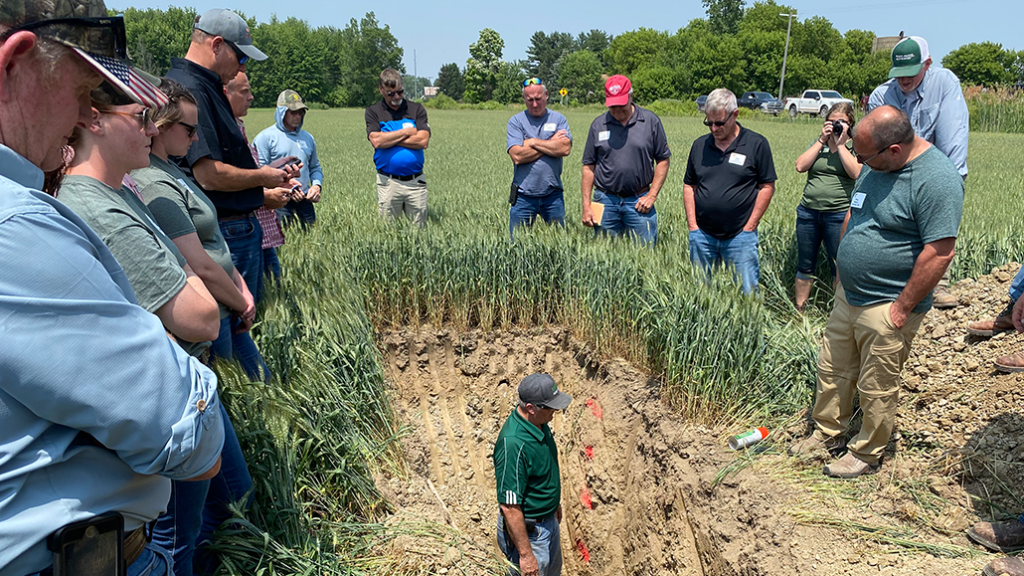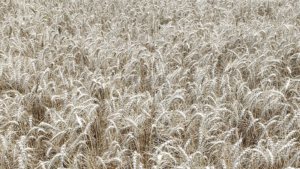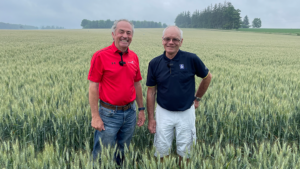Networking to grow great wheat
GREAT LAKES YIELD ENHANCEMENT NETWORK TOUR

THE GREAT LAKES Yield Enhancement Network (YEN) organized its first summer networking tour in June 2023 in central and Eastern Michigan. More than 30 growers and their families attended from all over the Great Lakes region, including Indiana, Michigan, New York, Ohio, and Ontario, as well as some very special guests from South Island, New Zealand. These growers represented 22 different Great Lakes YEN sites participating in 2023. Representatives from Michigan State University (MSU), Michigan Wheat Program, Ohio State University, Ontario Ministry of Agriculture, Food and Rural Affairs (OMAFRA), and Grain Farmers of Ontario also attended the tour to support the program’s ongoing success.
The tour kicked off at the Saginaw Valley Research and Extension Center, where participants heard from Eric Watson, the 2020 World Record Wheat Yield Winner. Eric planted his most recent world record-winning wheat on April 17, 2019, and harvested exactly 10 months later on February 17, 2020, with a yield of 17.398 tonnes per hectare (258.7 bushels per acre). Participants from both Ontario and the U.S. were excited to get the chance to ask questions about the different growing conditions and cropping practices Eric was using for his record yields, especially with regard to Eric’s significantly lower seeding density (~400,000 seeds per acre) compared to common practice in North America. (Read more about Eric Watson’s record wheat yield on page 10).
OPTIMAL PLANTING DATES
Participants heard from Joanna Follings, OMAFRA cereals specialist, and Emma Dieleman, a recent M.Sc. graduate and agronomist with NK Seeds, who discussed optimum winter wheat planting. They emphasized that both grain fill and growing season length are highly dependent on weather, so it is critical to plan ahead by seeding wheat after early harvested crops such as canola or edible beans, consider shorter season soybean varieties in fields that are intended for winter wheat, and have fertilizer and weed control plans in place and equipment prepared well in advance of seeding. Peter Johnson, an agronomist with RealAgriculture, enthusiastically explained the need for sufficient nitrogen levels in the soil for fungicide applications to be effective and provided an overview of his wheat partitioning study (funded in part by Grain Farmers of Ontario).
Participants then had the opportunity to head out into the research plots and hear from Dr. Eric Olson, assistant professor in wheat breeding and genetics at MSU, and Dr. Manni Singh, assistant professor of cropping systems agronomy at MSU, who provided a tour of their extensive winter wheat variety trial and provided an overview of their wheat canopy research, comparing the amount of light infiltration between varieties. Olson noted that his goal is to see the inclusion of a canopy cover index on seed labels within the next two to five years. Dennis Pennington, the wheat systems specialist at MSU, also spoke about the differences observed between high management and conventional management of the wheat varieties involved in the trial.
Day one wrapped up with a tour of Jeff Krohn’s Great Lakes YEN site, located outside of Owendale, where participants discussed the differences in soil texture between their fields and Krohn’s lighter, sandier soils. Krohn also showed off his specialized Pottinger seeder, which uses five-inch row spacing.
DAY TWO
Day two kicked off with an informative tour of the Star of the West Milling Company in Frankenmuth, which was established in 1870 and is currently the 11th largest milling company in the United States. Participants put on their hard hats and ear plugs to walk through the six floors of machinery within the mill, observing how the company takes wheat grain delivered from the field, cleans, sorts, grinds, and finally packages bags of flour that then get shipped directly to industry across the region. This particular mill grinds approximately 28,000 bushels of wheat every day, but the entire company has expanded over the years to include four other flour mills, six edible bean processing plants, 22 grain elevators, and five retail fertilizer plants.
Participants then headed to farmer plots; Rich D’Arcy shared posters outlining his inputs, with corresponding dates, on his Great Lakes YEN winter wheat plot located just outside of Kingston. D’Arcy also talked about his innovative use of cover crops, noting that he applies a 10+ species mix to all of his cropped acres, sparking a great conversation about the merits of cover crop use between participants. The tour concluded with a stop at Dwight Bartle’s farm outside of Brown City. Bartle had dug a fresh six-foot soil pit in one
of his wheat fields, and participants were fortunate to hear from his agronomist, John Mackson from MAX Agronomy LLC, who discussed some of the soil pit’s key findings, predominately that water movement is a critically important component of plant health as roots were evident five to six feet deep as the plants were in search of water after the severe lack of moisture over May and June. The soil pit also inspired discussion around the merits of conventional tillage versus no-till and experimentation with fungicide and fertility inputs, as many participants are still working to figure out what combination of inputs works best for them and their cropping system.
A SECOND ANNUAL TOUR PLANNED IN 2024
The Great Lakes YEN Steering Committee was pleased to lead discussions on the continued improvement and success of the YEN program before wrapping up the tour. Overall, participants stressed that educational opportunities, such as the summer networking tour, are one of the primary benefits of participating in the Great Lakes YEN program. The Steering Committee is already excitedly planning the 2024 summer networking tour, which will take place in Ontario.
More information on the Great Lakes YEN can be found by visiting www.GreatLakesYEN.com/.
Alexandra Dacey is the agronomy project coordinator at Grain Farmers of Ontario. •

























